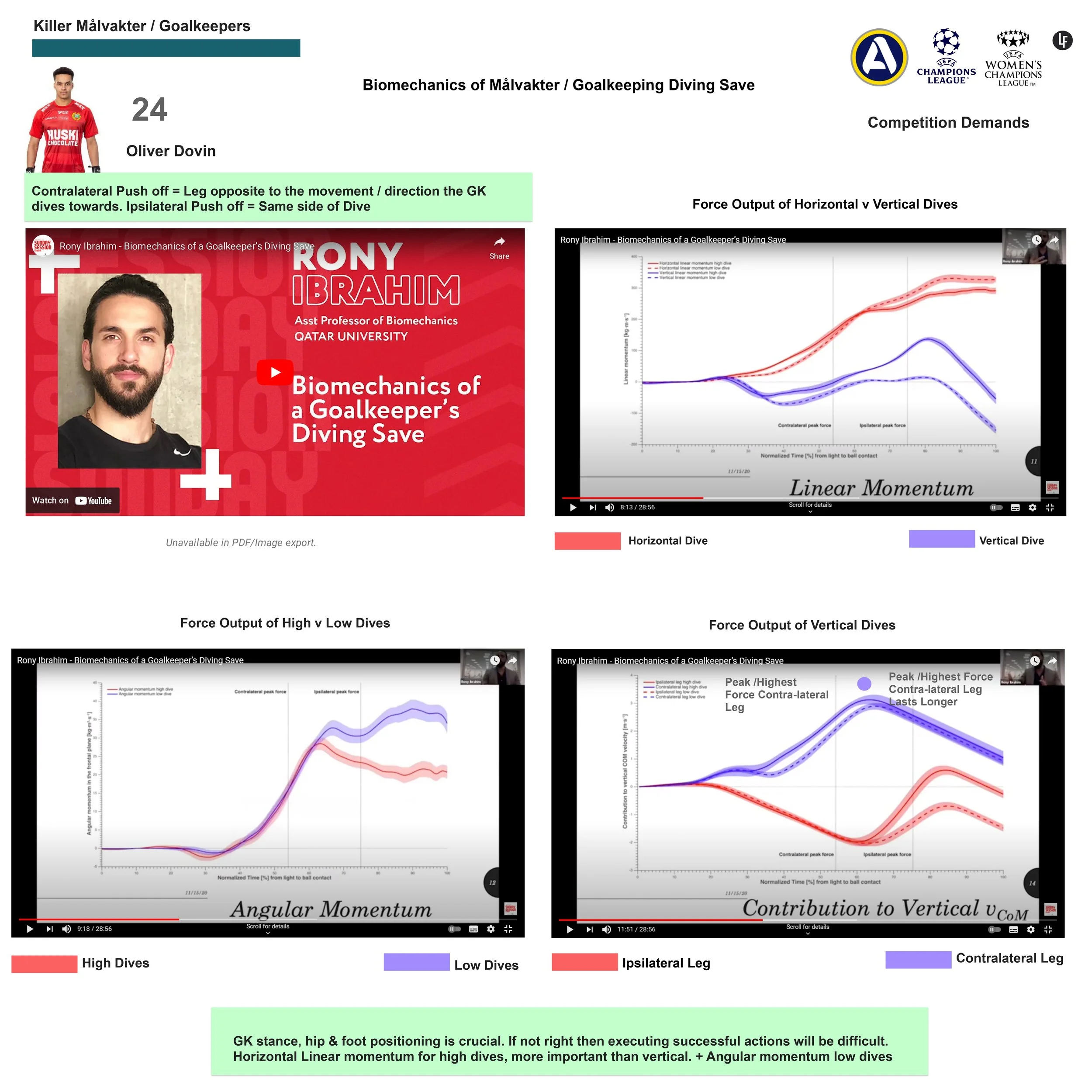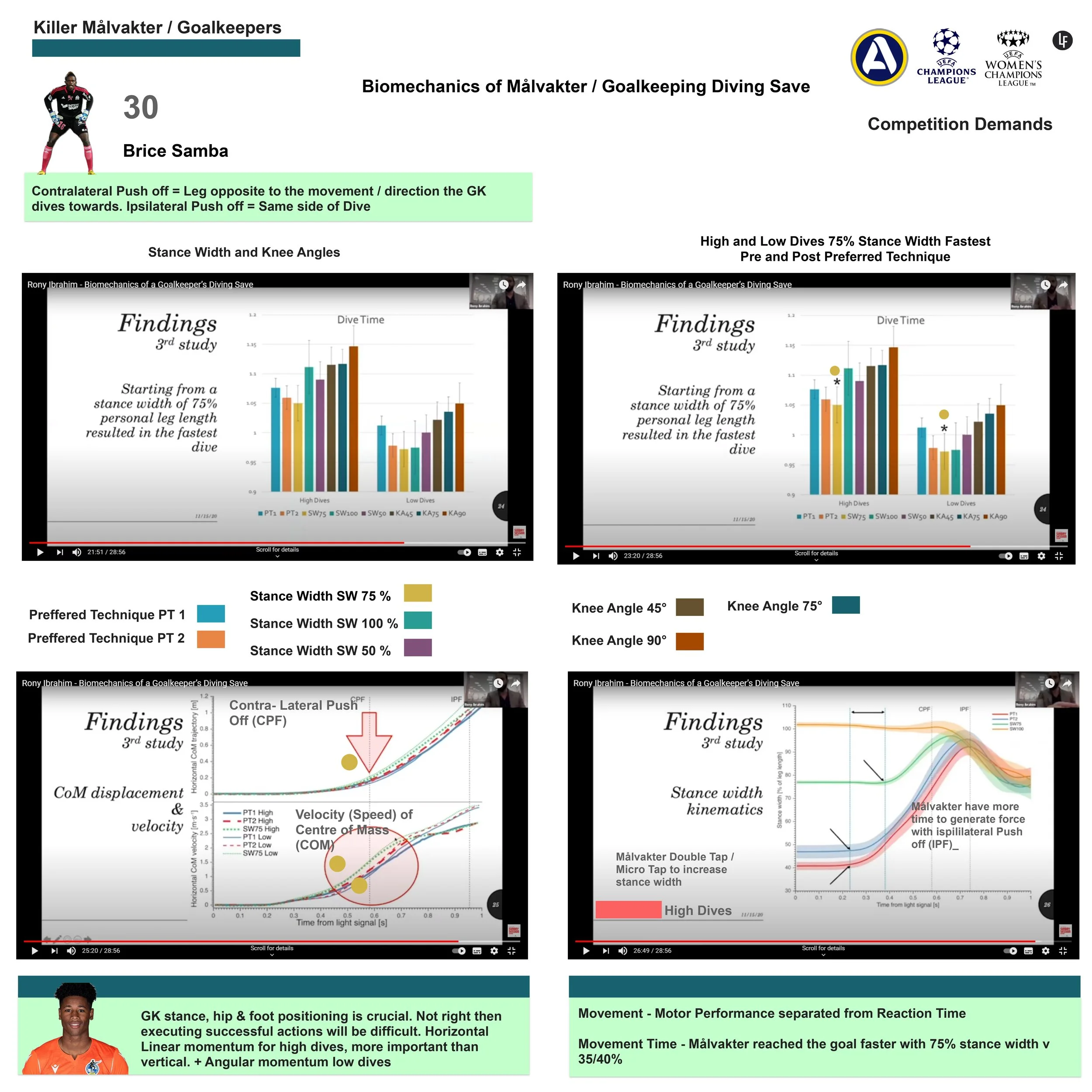Biomechanics of a Goalkeepers Diving Save
Biomechanics of Målvakter Goalkeeping Diving Save
In Sweden I started to work with GKs due to a coach shortage, enjoyed the technical side and continued to improve my knowledge. This I found of high value when programming for GKs and working with GK coaches. Not a lot is in this space regarding physical preparation as it is a highly specialist position, but I have created my own. But I will be sharing what I know, my work, and the programmes I have created for on and off the field in collaboration with GK's and GK coaches, particularly in Sweden. This also includes young developing goalkeepers.
Introduction
This is from the work of Assistant professor of Biomechanics Dr Rony Ibrahim et al from Qatar University. He and his team analysed the biomechanics of a goalkeepers diving save.
Key: Contralateral Push off = Leg opposite to the movement / direction the GK dives towards. Ipsilateral Push off = Same side of Dive
Trolley Pushes to help with Push off when Diving. Under leg push off (Contra Lateral) Rehabilitation (Knee Injury) and Power Development (Single Leg Power) Touching the feet helps the brain with sensory re-connection the with foot. Builds confidence for Diving in the Swedish Damallsvenskan League.
Study 2 Subject: Nine Elite La Liga GK's using Ball cannon.
I will start with the force output of horizontal versus vertical dives and linear momentum. The solid lines in blue and red are high dives, the dashed lines are low dives. What he found is GKs produce much more horizontal momentum, which is in red, much more than vertical dives and this is for both high and low dives.
If we look at the force output of high versus low dives and angular momentum. Low dives are in blue, there is much more force in low dives. GK’s need to turn and fall as quickly as possible for low dives.
Biomechanics &
Force Output of GKs
Force output of vertical dives and contribution to vertical velocity of centre of mass towards the ball. Looked at the Ipsilateral leg and the contra-lateral leg using force plates to see how much power each leg is generating. Vertical contralateral leg is in blue. The Ipsilateral leg is the last leg that leaves the ground. The contra-lateral leg is contributing the peak force. Also, this last longer in the dive.
Force Output of Horizontal Dives
Clear contribution of the contra-lateral leg which is in blue and the Ipsilateral leg in red. At the start of the dive the power is clear, a steeper curve and this of horizontal centre of mass (com). The contralateral leg is much more important, contributes to com velocity (speed). Horizontal linear momentum / dives are much more significant than vertical jumps. So, the focus in training should be horizontal (sideways/Lateral).
Study Two with nine elite goalkeepers used ball cannon - Globus. High balls set at 190cm and low balls 30cm, plus or minus 10cm. Speed calibrated at 1.2 seconds. This is the force output of joint, joint moment, joint angular velocity (speed). This is the force output of joint, joint moment, joint angular velocity (Speed). The first column is hip flexion and extension. The second column along is hip abduction and adduction in a frontal plane. Third knee joint flexion and extension, fourth is the ankle joint, plantar flexion dorsi flexion towards shins and away.
Looking at joint moments, not a lot forces generated. Big moments around hip extension, contra-lateral is in blue and Ipsilateral in red, all the way through. Joint power is highest from hip extension and ankle plantar / dorsiflexion. The magnitude is in terms of values. They also looked at joint and muscle coordination sequence.
Hip
Knee
Ankle
Hips start first, with both legs, in terms of peak power. Contra-lateral first and then Ipsilateral GK dive is not simultaneous, it is one leg and then the other.
Goalkeeper Stance Width
& Knee Angles
The Third study analysed stance width and imposed three different stance widths.
50%
75%
100%
This also included three different knee angles. PT1 and PT2 is preferred technique before any changes.
Method: Goalkeepers completed two sets to normalise results, before and after changes. Goalkeepers were faster with a stance width of 75% rather than the preferred technique and 75 % rather than the preferred 35% and 40%.
Velocity of 75% started to shift, this sustained, main difference between preferred technique and 75% stance width.
Goalkeepers increase stance width, doing a double tap or micro tap even if starting from a PT1 stance. More force in the contralateral push off, able to produce more centre of mass (com) quicker. Focus for training should be of 75% leg length for optimal positions on the pitch and in the gym.
Video 7.28 mins Watch and Listen
Goalkeepers Saving Dive
A Retrospective. Here I explain the study by Rony Ibrahim et al (2019) looking at the bio-mechanic subsections of force and motion (movement) of a goalkeepers diving save.
Resource: Ibrahim, R., Kingma, I., de Boode, V. A., Faber, G. S., & van Dieën, J. H. (2018). Kinematic and kinetic analysis of the goalkeeper’s diving save in football. Journal of Sports Sciences, 37(3), 313–321. https://lnkd.in/eE5qHPpf


